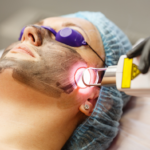Undergoing a chemical peel can result in radiant, refreshed skin when adequately cared for afterward. Following the recommended aftercare routine is crucial for ensuring your skin reaps the full benefits. From wearing sunscreen religiously to keeping your face moisturized, small daily actions protect your skin’s renewal process. Adopting good practices minimizes irritation and improves your complexion.
This guide covers simple tips to maximize rejuvenation and achieve radiant results.
What to Expect Immediately After Your Cool Peel Treatment
Once your Cool Peel session is complete, there are a few things you will likely experience.
A Warm, Sun-kissed Skin Sensation
First, you will notice that the treated areas of your skin feel very warm. They may be flushed and feel sort of like you have a moderate sunburn. This warm, sun-kissed skin feeling is normal after a chemical peel session. It is caused by increased blood flow to the treated areas. This helps your skin heal. The warmth normally goes away within around an hour after the peel is done. Most patients find this sensation quite comfortable; it is not very painful.
You may also notice a slight peeling and flaking of the skin. This is another normal reaction that shows the treatment is working properly. Dead skin cells and damaged areas will start to peel away. Revealing fresher, glowing layers underneath. Peeling and flaking usually peak around 2-5 days after the peel and then gradually taper off over the next week as the skin renewal process completes. The amount of peeling varies per patient. Your provider can guide you on what to expect based on your peel depth and strength.
Temporary Sandpaper Texture
After your cool peel laser treatment, the texture of your skin will likely feel different temporarily. This is normal. The treated areas often develop a rougher, drier, sandpaper-like texture in the first few days. This happens as the damaged outer layers start peeling away. The freshly revealed skin underneath is still sensitive at first.
You can expect the treated skin to feel extra rough and dry for around 3 to 4 days after the peel. During this time, be sure to moisturize your skin gently. This will help provide relief and comfort as the old, flaky skin detaches. It also helps protect and hydrate the sensitive new layers underneath.
After the initial flaky dead skin peels off, the fresh regenerated tissue will be uncovered. This new skin will feel much smoother and softer. Continuing regular moisturizer application helps this baby-soft skin emerge and stabilize. Your skin may still be a bit dry as it adjusts and rebalances post-peel. But the sandpaper roughness should subside within a week or so.
Mild Redness Up to 48 Hours
It is common to experience some mild redness or inflammation for the first day or two after your Cool Peel treatment. Especially if more aggressive peel depths were used. As the damaged skin sheds off, it is normal for the newly exposed skin to appear slightly red temporarily.
However, any severe or prolonged redness lasting longer than 48 hours needs a medical assessment. If the skin remains severely red, swollen, hot, and inflamed beyond 2 days post-peel, contact your doctor. This could signal an infection or an abnormal reaction.
In most cases, the redness is tolerably mild, fading after an initial day or so. Some patients find over-the-counter aids help ease discomfort while the skin heals. Oral pain medication, antihistamines, or applying cold compresses provide relief for some patients during the first stages of healing. Always follow dosing guidelines and instructions if taking any medications. Alert your provider to your concerns for proper guidance.
While usually well-tolerated, taking the proper steps aids healing after a more aggressive Cool Peel session. Stay in touch with your provider’s office during the initial phases if worries arise.
Caring For Skin in the First 48 Hours After Treatment
Properly caring for freshly treated skin is crucial in the first 2 days following your Cool Peel session. Certain steps aid healing and minimize side effects. Here are some tips for ideal at-home care immediately after your peel treatment:
Cleanse Gently
Use a very soft, gentle touch when cleansing the skin for the first 48 hours post-peel. Cleanse the treated areas twice a day with lukewarm water and a mild cleanser only. Avoid irritants like scrubs, toners, or products with acids. Ideal cleansers are fragrance-free options such as Cetaphil. Gently pat dry skin after rinsing the cleanser. Cleansing removes debris to prevent infection as treated tissue heals. But harsh scrubbing can disrupt the renewal process.
Moisturize Frequently
Apply moisturizer generously after each cleansing session. Your provider can recommend occlusive creams with antioxidants, ideal for post-procedure use. These provide extra hydration to soothe the skin as roughness and flaking occur. Frequently moisturizing also slows water loss while the outer barrier restores itself. It supports overall renewal.
Avoid Makeup
Give skin a 48-hour break from all makeup like foundations, powders, lipstick, and eye products after a peel session. Pigments can clog pores and lead to issues like infection or hyperpigmentation.
Use Sun Protection
Wear wide-brimmed hats and UV-blocking clothing outdoors. Use broad-spectrum sunscreen on any uncovered skin, reapplying every 2 hours. Exposure to the sun can significantly worsen irritation and inflammation. Take measures for total UV protection during healing time.
Managing Redness, Dryness, and Textural Changes After Treatment
It’s normal to experience some temporary redness, peeling, breakouts, warmth, and tingling after your Cool Peel treatment. This shows the renewal process is progressing as expected. Damaged skin sheds off to reveal fresher layers.
Redness typically lasts 1-2 days, up to 5 days after more aggressive peels as new skin uncovers. Let peeling skin detach naturally rather than picking at it. Acne flare-ups are possible as pores purge debris – refrain from squeezing to prevent scars while skin stabilizes. Mild sensitivity usually subsides within a week.
Most discomfort typically resolves around day 5 post-treatment. However, if severe symptoms continue beyond 7 days, follow up with your provider to keep your renewal on track. Ongoing issues warrant medical guidance to ensure proper healing.
Extra Care Steps for Aggressive, Ablative Treatments
More Intensive Procedures Require Additional Healing Precautions
Where more ablative lasers like the Tetra CO2 are used at higher intensities, additional measures may enhance patient comfort and speed recovery beyond basic Cool Peel aftercare.
Vinegar Soaks Help Prevent Scarring
Gently wiping treated areas twice daily with gauze soaked in cool white vinegar can aid the separation of scab tissue. This aids in preventing scab buildup and scarring.
Barrier Ointments Reduce Oozing and Crusting
Applying a layer of Aquaphor allows the seeping serum from weepier ablative wounds to flow out freely. This avoids scab crusting, which delays overall healing timelines.
Oral Antivirals Prevent Cold Sore Breakouts
In cases of viral outbreak triggers, providers may prescribe antiviral medications prophylactically. This prevents secondary cold sore flare-ups caused by severe skin disruption.
| Aftercare Aspect | Standard Cool Peel | Aggressive Ablative Laser |
| Typical Redness | 1-2 days | 3-7 days |
| Texture Changes | 3-4 days | 5-10 days |
| Soaks/Compresses | Not required | It is helpful for scab removal |
| Added Medications | Rarely needed | Antivirals and pain relief are possible |
Lifestyle Considerations for Ideal Recovery After Treatment
Your daily habits and environment can impact how well your skin recovers after a Cool Peel session. There are a few precautions to take during the 2 weeks following your treatment for optimal results:
Soak Up the Shade
It’s vital to avoid direct sunlight exposure for at least 7 days post-procedure. UV exposure significantly delays wound closure and skin renewal after a resurfacing treatment. Whenever going outside, be sure to wear wide-brimmed hats and apply the highest SPF sunscreen to uncovered areas. Seeking shade supports better healing.
Take It Easy with Exercise
Don’t overheat the treated skin or sweat heavily for 72 hours after your peel. It’s best to skip hot yoga classes, intense gym sessions, or sauna visits during initial recovery when the skin is extra vulnerable. Gentle movement is fine but limits extreme heat and perspiration, which irritate freshly treated tissue.
Sleep on Your Back
Try sleeping propped up on your back rather than your stomach or sides. Letting treated facial areas press into pillowcases all night risks irritation, bacteria transfer, and raw skin friction. Back sleeping avoids this, with the skin hovering freely.
Limit Face Coverings Like Masks
For 1 to 2 weeks while the skin stabilizes, minimize wearing opaque face coverings as much as possible. Trapped heat, moisture, and friction from masks can disrupt the renewal process. Check with your provider when it’s safe to resume regular masking after your peel procedure.
Making a few easy lifestyle adjustments for 7 to 14 days ensures your treated skin recovers in the healthiest way possible. Take all precautions to nurture your complexion’s rebirth after your Cool Peel treatment!
Long-Term Skincare and Maintaining Treatment Effects
While initial recovery only takes about a week, appropriate ongoing care preserves your Cool Peel’s rejuvenated glow long-term:
Follow your clinician’s customized regimen using topicals like retinoids and vitamin C to maintain even tone and clarity. Rigorously apply broad-spectrum SPF 30+ sunscreen daily, as fresh skin remains exceptionally sensitive to UV damage.
Though one session brings noticeable improvements, repeat treatments every 4-6 weeks are advised to progressively enhance results until your aesthetic goals are met. Thereafter, annual touch-up sessions help sustain optimal skin quality for years. With proper maintenance, your youthful complexion can last.
Final Thoughts
Getting a Cool Peel treatment performed by a qualified dermatology provider can significantly improve aging and sun-damaged skin. However, properly caring for skin post-procedure is imperative to achieve lasting rejuvenation. Following aftercare best practices reduces side effects and discomfort while supporting the renewal process. Within a week or two, your patience pays dividends in the form of refreshed, glowing skin that looks dramatically younger. Invest some focused TLC in your complexion early on so you can enjoy a radiantly revitalized complexion long-term after your Cool Peel.
Frequently Asked Questions
- How long will my skin stay sensitive after a Cool Peel?
Feeling some sensitivity to wind, temperature changes, and even dabbing for a good 2 weeks after your treatment is common. Give your fresh complexion some extra TLC as it rebalances. Use a gentle cleanser, ample moisturizer, and sunscreen until the skin adjusts back to normal.
- When can I resume my regular skincare routine?
You can start cleansing very gently in the morning after your peel. But hold off on potentially irritating alpha and beta hydroxy acids, retinoids, and vitamin C serums until about day 5 post-treatment when the skin is less reactive. Starting too soon may cause inflammation.
- Is skin peeling normal?
Yep, a bit of superficial dry flaking and peeling in the first 5 to 7 days is very normal and not a concern. Allow those outer layers to naturally slough off, revealing the radiant skin underneath! Don’t pick at peeling skin or over-scrub which slows the process.







